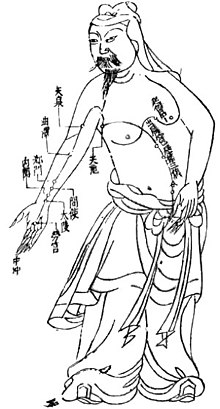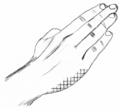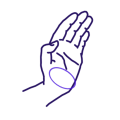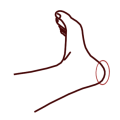Kyusho Jitsu
Kyūsho Jitsu ( Japanese 急 所 術 , dt. "Art of vital points") describes the knowledge of the "vital points" of the human body and their use in martial arts. Kyūsho Jitsu is not an independent martial art and is not trained as such in Japan. It is a method of working with vital points based on the knowledge and principles of acupuncture and the connection to western neurology , which can be integrated into numerous martial arts. The so-called principles, which are supposed to improve the effectiveness of the vital point stimulation, stand above the knowledge about the vital points.
Description of Kyūsho Jitsu
In the non-Japanese martial arts the vital points are known under the names Dim Mak or Dianxue (Chinese styles), Kupso Sul or Hyol Do Bop (Korean styles) or Marma-Adi (India).
In Kyūsho Jitsu, the neurological or physiological processes of the human body are to be influenced in such a way that the body is impaired by manipulating the points. This can occur in the form of reflex reactions , pain, imbalance, loss of strength and even loss of consciousness. On the other hand, as in traditional Chinese medicine , the knowledge acquired can also be used to alleviate various ailments.
Explanatory models
There are two different explanatory models of Kyūsho Jitsu. The traditional explanatory model of Kyūsho Jitsu uses traditional Chinese medicine . It is based on the meridian system of acupuncture . The naming of the vital points is also based on the meridian system. Another model is based exclusively on western knowledge of medicine and uses this to describe the effects of punches and grips. These include trauma , tissue injuries, nerve shock, and tendon or muscle injuries. The effectiveness of these techniques can be scientifically proven according to our state of medicine.
Usually a mixture of both models is conveyed. The necessary knowledge and techniques can be acquired with both models.
techniques
There are many ways of hitting and kicking. In Kyūsho, point accuracy is one of the main characteristics. Normal techniques like oizuki (punching) do not produce the perfect effect. The most important hand techniques are rather Ippon-Ken, Shute, Haito, Teisho, Keito and Hiraken. When it comes to leg techniques, the selection is rather small. B. Hiza Geri, Sokuto, Kakato. Instead of hitting or kicking, there is also the option of stimulating the vital points by grasping or pressing. The execution of the techniques corresponds optically to those of many other martial arts, but as already mentioned, point accuracy, correct angle and direction of attack are decisive for the effect. In Kyūsho Jitsu, the use of force is often low, as the nerve points are very sensitive. Therefore it is not decisive whether you are physically fit. Even a young child or an old person can use this technique.
To learn the techniques, you can practice on a boxing dummy, claws or makiwara . However, human training is essential.
- Hand techniques
- Leg techniques
Master of Kyūsho Jitsu
Masters who teach this art include George Dillman, Evan Pantazi, Jean Paul Bindel, Achim Keller, Kelly Sach, Manfred Zink and Fritz Oblinger. According to the statements of the masters, one can quickly learn the basic techniques of self-defense. However, only intensive study and practice lead to mastery. Kyusho is often passed on through the individual kata . Pantazi, Gencoglu, Haingärtner and Sach have built the points into self-defense techniques that can be implemented immediately in self-defense situations. Because of their effectiveness, the nerve pressure points are also considered to be useful in self-defense for older people.
See also
Individual evidence
- ↑ George Dillman: About George Dillman. 2012, accessed on August 31, 2013 .
- ↑ Kyusho.com. Retrieved August 31, 2013 .
- ↑ SOK-Kyusho-Jitsu - German Karate Association e. V. Accessed December 24, 2016 .
literature
- Fritz Oblinger: The vital point methods of the old masters: Kyusho-Jitsu in karate . Palisander Verlag 2016, ISBN 978-3-938305-96-6
- Manfred Zink: Kyusho-Jitsu: Secrets of Vital Points, Workbook Volume 1 , Kyusho-Verlag, ISBN 978-3-945172-00-1
- Manfred Zink: Kyusho-Jitsu: Secrets of Vital Points, Workbook Volume 2 , Kyusho-Verlag, ISBN 978-3-945172-01-8
- Manfred Zink: Kyusho-Jitsu: Secrets of Vital Points, Workbook Volume 3 , Kyusho-Verlag, ISBN 978-3-945172-02-5
- George A. Dillman, Chris Thomas: Kyusho-Jitsu: the Dillman method of pressure point fighting. 1992, ISBN 0-9631996-0-9 .
- Evan Pantazi: Kyusho-Jitsu: The vital points of the human body in martial arts. Sportimex 2004, ISBN 978-84-96492-00-4 .
- Ralph Thannhäuser: The Jintai Kyusho of Karate. Monsenstein and Vannerdat 2013, ISBN 978-3-86991-998-0 .








